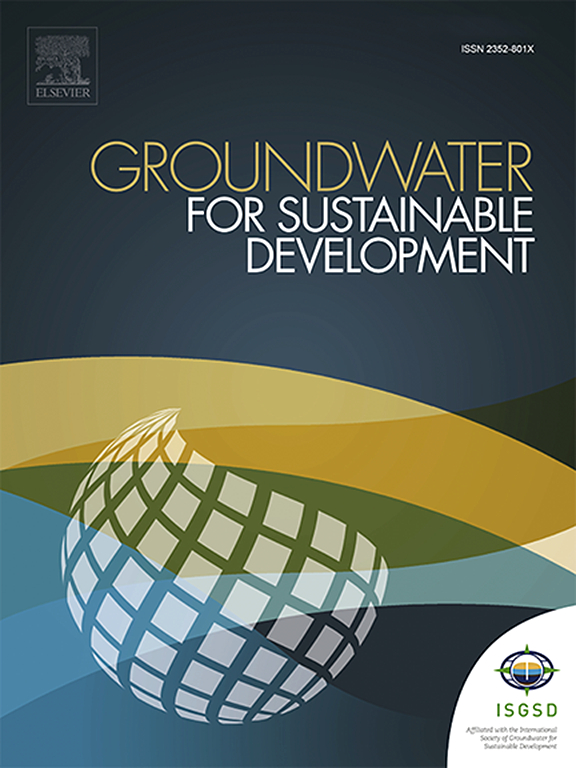Comprehensive multifaceted analysis for unveiling the driving factors of groundwater decline
IF 4.9
Q2 ENGINEERING, ENVIRONMENTAL
引用次数: 0
Abstract
Groundwater, as a vital water resource in arid and semi-arid regions, plays a crucial role in sustaining human livelihoods, agriculture, and industry. Over recent decades, these areas have witnessed rapid groundwater depletion, raising concerns about resource sustainability. This research provides a comprehensive analysis of the factors contributing to the decline in groundwater levels (GWL) within the Marand Plain, a heavily exploited area with complex groundwater dynamics in northwestern Iran. To achieve this objective, a novel approach based on Maximal Overlap Discrete Wavelet Transform (MODWT) entropy analysis was introduced to explore the complexities governing the groundwater system across various periods. The next step involved conducting a non-parametric trend analysis of the GWL through Mann-Kendall tests to interpret declining trends in relation to hydro-climatological factors and vegetation dynamics represented by NDVI. In the final phase, the study employed Wavelet Transform Coherence (WTC) and Partial Wavelet Coherence (PWC) to thoroughly examine scale-dependent control of various surface factors within the groundwater system., The findings indicate a limited impact of climate change parameters on the GWL decline. However, the results highlight the significance of vegetation dynamics, driven by land use changes, as a primary factor contributing this decline.

揭示地下水下降驱动因素的综合多方面分析
地下水是干旱半干旱地区的重要水资源,在维持人类生计和农业、工业等方面发挥着至关重要的作用。近几十年来,这些地区的地下水迅速枯竭,引起了人们对资源可持续性的关注。本研究对马兰平原地下水位下降的影响因素进行了综合分析,马兰平原是伊朗西北部一个地下水动态复杂的严重开发地区。为了实现这一目标,引入了一种基于最大重叠离散小波变换(MODWT)熵分析的新方法来探索地下水系统在不同时期的复杂性。下一步是通过Mann-Kendall检验对GWL进行非参数趋势分析,以解释与NDVI代表的水文气候因子和植被动态相关的下降趋势。在研究的最后阶段,采用小波变换相干性(WTC)和部分小波相干性(PWC)深入研究了地下水系统中各种地表因子的尺度依赖性控制。研究结果表明,气候变化参数对GWL下降的影响有限。然而,研究结果强调了由土地利用变化驱动的植被动态是导致这种下降的主要因素。
本文章由计算机程序翻译,如有差异,请以英文原文为准。
求助全文
约1分钟内获得全文
求助全文
来源期刊

Groundwater for Sustainable Development
Social Sciences-Geography, Planning and Development
CiteScore
11.50
自引率
10.20%
发文量
152
期刊介绍:
Groundwater for Sustainable Development is directed to different stakeholders and professionals, including government and non-governmental organizations, international funding agencies, universities, public water institutions, public health and other public/private sector professionals, and other relevant institutions. It is aimed at professionals, academics and students in the fields of disciplines such as: groundwater and its connection to surface hydrology and environment, soil sciences, engineering, ecology, microbiology, atmospheric sciences, analytical chemistry, hydro-engineering, water technology, environmental ethics, economics, public health, policy, as well as social sciences, legal disciplines, or any other area connected with water issues. The objectives of this journal are to facilitate: • The improvement of effective and sustainable management of water resources across the globe. • The improvement of human access to groundwater resources in adequate quantity and good quality. • The meeting of the increasing demand for drinking and irrigation water needed for food security to contribute to a social and economically sound human development. • The creation of a global inter- and multidisciplinary platform and forum to improve our understanding of groundwater resources and to advocate their effective and sustainable management and protection against contamination. • Interdisciplinary information exchange and to stimulate scientific research in the fields of groundwater related sciences and social and health sciences required to achieve the United Nations Millennium Development Goals for sustainable development.
 求助内容:
求助内容: 应助结果提醒方式:
应助结果提醒方式:


